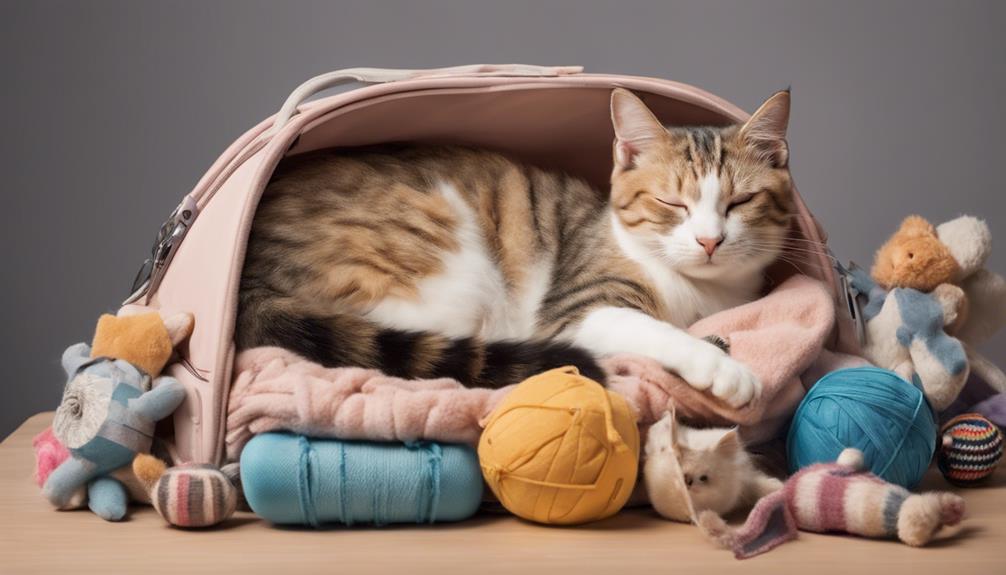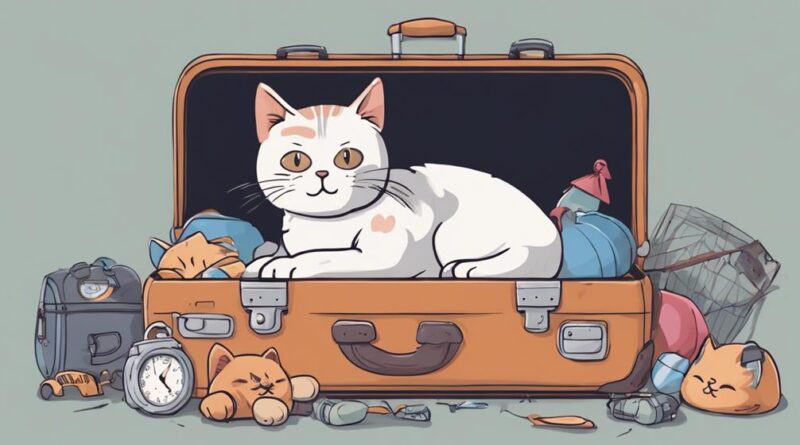How to Manage Your Cat's Jet Lag During Travel
When it comes to managing your cat's jet lag during travel, think of it as similar to adjusting your own internal clock after a long flight. The well-being of your feline companion is just as important as your own, and ensuring they smoothly transition to new time zones is crucial for their comfort and health.
From understanding the effects of jet lag on cats to practical tips for easing their adjustment, there are key strategies you can implement to make your travels together a stress-free experience.
Understanding Cat Jet Lag
Wondering how jet lag affects your furry feline friend during travel? Cats, like humans, have intricate sleep patterns regulated by their circadian rhythms. These rhythms, controlled by the brain's hypothalamus, dictate when your cat feels sleepy or awake. When traveling across time zones, your cat's circadian rhythms get out of sync, leading to what we commonly refer to as jet lag.
Jet lag can disrupt your cat's usual sleep patterns, causing them to be awake when they'd normally be sleeping and vice versa. Just like humans, cats may experience fatigue, irritability, and a general sense of disorientation due to this misalignment of their internal clock. It's essential to help your cat adjust to the new time zone gradually to minimize the effects of jet lag.
To assist your cat in adapting to the new schedule, try to gradually shift their feeding and playtime routines closer to the local time. Exposing your cat to natural light during the day can also help reset their circadian rhythms. Ensuring your cat has a comfortable and familiar sleeping environment can aid in promoting better sleep quality during the adjustment period.
Understanding your cat's sleep patterns and circadian rhythms is crucial in managing their jet lag during travel. By being attentive to their needs and making small adjustments to their routine, you can help your feline companion overcome the challenges of traveling across different time zones.
Preparing for Travel With Your Cat
When getting ready to travel with your cat, it's important to plan ahead and make necessary preparations to ensure a smooth journey for both you and your feline companion. Start by scheduling a pre-travel checkup with your veterinarian. This checkup will ensure that your cat is healthy enough for the journey and is up to date on all vaccinations. It's also a good opportunity to discuss any specific concerns or precautions for traveling with your cat.
In terms of packing essentials, make sure to bring your cat's favorite blanket or bed to provide comfort and familiarity during the trip. Pack enough food and water for the journey, along with any medications your cat may need. Don't forget to include a leash, harness, and a secure carrier to transport your cat safely.
Additionally, it's crucial to have your cat's identification and medical records on hand in case of emergencies. Ensure your cat is wearing a collar with an ID tag that includes your contact information. Microchipping your cat is also highly recommended for added security.
Minimizing Disruption to Routine

To minimize disruption to your cat's routine during travel, establish a familiar environment as much as possible. Cats thrive on routine and familiarity, so when traveling, try to maintain similar boundaries and schedules to what they're used to at home. Setting boundaries in a new environment can help your cat feel secure and reduce stress. Bring along their favorite toys, blankets, or bedding to create a sense of comfort and normalcy. Additionally, maintaining a consistent routine for feeding, playtime, and sleep will help your cat adapt to the new surroundings more easily.
When traveling with your cat, establishing a routine is crucial in minimizing disruptions. Try to stick to their usual feeding and play schedule as closely as possible. Cats feel more at ease when they know what to expect, so keeping their routine consistent can help them adjust quicker. This means feeding them at the same times each day, engaging in play sessions they're accustomed to, and ensuring they've a quiet and comfortable space to rest. By maintaining their routine, you provide a sense of stability that can significantly reduce the impact of travel on your cat's well-being.
Adjusting Feeding and Water Schedule
Maintaining your cat's regular feeding and water schedule is essential during travel to help them adjust smoothly to the new environment. Here are some tips to help you manage your cat's hydration and meal timing effectively:
- Hydration Tips:
- Ensure your cat has access to fresh water at all times during the journey.
- Encourage your cat to drink water by adding a few drops of tuna juice to it or using a pet water fountain.
- Meal Timing:
- Stick to your cat's regular feeding schedule as much as possible to provide a sense of routine.
- If traveling across time zones, gradually adjust the timing of meals to align with the new destination.
Creating a Comfortable Travel Environment
Creating a comfortable travel environment for your cat involves ensuring their surroundings are familiar and cozy to reduce stress and anxiety. When preparing for a trip with your feline friend, there are essential items to pack as well as comfort measures to consider.
Travel essentials include items like your cat's favorite blanket or bed, familiar toys, their regular food and treats, a portable litter box, and any medications they may need. These familiar items will provide a sense of security and comfort during the journey. Additionally, make sure to have a sturdy carrier that's well-ventilated and spacious enough for your cat to move around comfortably.
Comfort measures play a crucial role in helping your cat feel at ease while traveling. Consider using pheromone sprays or calming collars to reduce anxiety. You can also cover the carrier with a blanket to create a dark and quiet space for your cat to relax. Providing fresh water and occasional treats can help keep your cat hydrated and content during the trip.
Helping Your Cat Adjust to Time Zones
When traveling with your cat across different time zones, helping them adjust to the new schedule is essential for their well-being and comfort. Cats, like humans, can experience jet lag due to changes in time zones, disrupting their sleep patterns and daily routines.
Here are some tips to assist your feline friend in adapting smoothly:
- Gradual Adjustment: Begin adjusting your cat's feeding and playtime schedule a few days before your trip to align with the new time zone.
- Natural Light Exposure: Expose your cat to natural light during the day in the new time zone to help regulate their internal clock and encourage appropriate sleep patterns.
- Establish Routine: Set a consistent daily routine with regular feeding times, play sessions, and sleep schedules to help your cat adjust to the new time differences.
- Comfort and Familiarity: Provide your cat with familiar bedding, toys, and scents from home to create a sense of security in the new environment and aid in their adjustment to the time zone changes.
Providing Familiarity in New Settings

To help your cat adjust to new settings, ensure you provide familiar objects that carry their scents and offer a sense of comfort and security. Comfort items like their favorite blanket, toy, or bed can provide a sense of familiarity in unfamiliar surroundings. These items act as routine reminders of home and can help reduce your cat's stress levels during travel.
Incorporating familiar scents into your cat's new environment can also aid in their adjustment. Bringing along items that smell like home, such as a piece of clothing with your scent or their bedding, can provide a comforting and reassuring presence. Additionally, using synthetic pheromone sprays designed to reduce stress in cats can help create a calming atmosphere in new spaces.
Designating safe spaces for your cat in unfamiliar settings is crucial. Set up a quiet area with their essentials like food, water, and litter box where they can retreat and feel secure. This space should be away from high-traffic areas to give your cat a sense of privacy and control over their surroundings.
Monitoring Your Cat's Behavior and Health
Keep a close eye on your cat's behavior and health during travel to ensure they're comfortable and adapting well to their new surroundings. Monitoring your cat's well-being is crucial to address any issues promptly. Here are some essential tips to help you with this:
- Health Check
Ensure your cat's overall health is stable throughout the journey. Keep an eye out for any signs of distress, such as excessive meowing, lethargy, or refusal to eat or drink. It's a good idea to pack a small travel kit with your cat's medical records, medications, and necessary supplies in case of emergencies.
- Behavior Observation
Pay attention to your cat's behavior as it can indicate how they're coping with the travel stress. Look for signs of anxiety, such as excessive grooming, hiding, or aggressive behavior. Providing familiar items like their favorite toys or blankets can help them feel more at ease.
- Regular Check-ins
Take breaks during your journey to interact with your cat and assess their well-being. Offer them food, water, and a chance to stretch their legs in a secure environment. This will also help strengthen your bond with your feline friend.
- Consult a Vet
If you notice any concerning changes in your cat's health or behavior, don't hesitate to seek advice from a veterinarian. They can provide guidance on how to manage your cat's jet lag and ensure a smooth travel experience for both of you.
Frequently Asked Questions
Can I Give My Cat Medication to Help With Jet Lag During Travel?
You can't give your cat medication for jet lag during travel. Instead, consider natural remedies like adjusting feeding and playtime schedules gradually before the trip.
Behavioral training, like creating a comfortable travel environment and maintaining a routine during the journey, can help ease your cat's transition.
How Can I Prevent My Cat From Becoming Anxious or Stressed During Travel?
To prevent your cat from getting anxious or stressed during travel, bring interactive toys and comfort items.
Toys like feather wands or laser pointers can keep your cat entertained, while familiar blankets or a piece of clothing with your scent can provide comfort.
These items can help distract your cat and create a sense of security, reducing their anxiety and stress while on the go.
Should I Limit My Cat's Activity Before and After Traveling to Help Them Adjust to Time Zone Changes?
To help your cat adjust to time zone changes, it's a good idea to limit their activity before and after travel.
By adjusting their exercise routine and sleep schedule gradually, you can ease them into the new time zone more smoothly.
This approach can help minimize any disruptions to their internal clock and make the transition easier for your furry companion.
Is It Safe to Use Calming Pheromone Products or Supplements to Help My Cat Adjust to a New Environment?
Using natural remedies, like calming pheromone products or supplements, can be safe for helping your cat adjust to a new environment. These alternatives can be effective in reducing stress and anxiety.
Behavioral training and techniques may also play a role in helping your cat acclimate to changes in their surroundings. It's essential to consult with your veterinarian to find the best approach for your feline friend's specific needs.
How Long Does It Typically Take for a Cat to Fully Adjust to a New Time Zone After Traveling?
When traveling, cats usually take a few days to fully adjust to a new time zone. During this time frame, your furry friend might experience disruptions in their sleep schedule and daily routine.
It's important to be patient and give them time to acclimate naturally. Gradually introduce them to the new environment and maintain a consistent feeding and play schedule to help them settle in more quickly.
Conclusion
Overall, managing your cat's jet lag during travel requires careful planning and attention to their needs.
By preparing for the journey, minimizing disruptions to their routine, and creating a comfortable environment, you can help your feline friend adjust to different time zones and new settings.
Remember to monitor their behavior and health closely, providing familiarity and reassurance along the way.
With patience and care, you can ensure a smooth and stress-free travel experience for your beloved cat.
